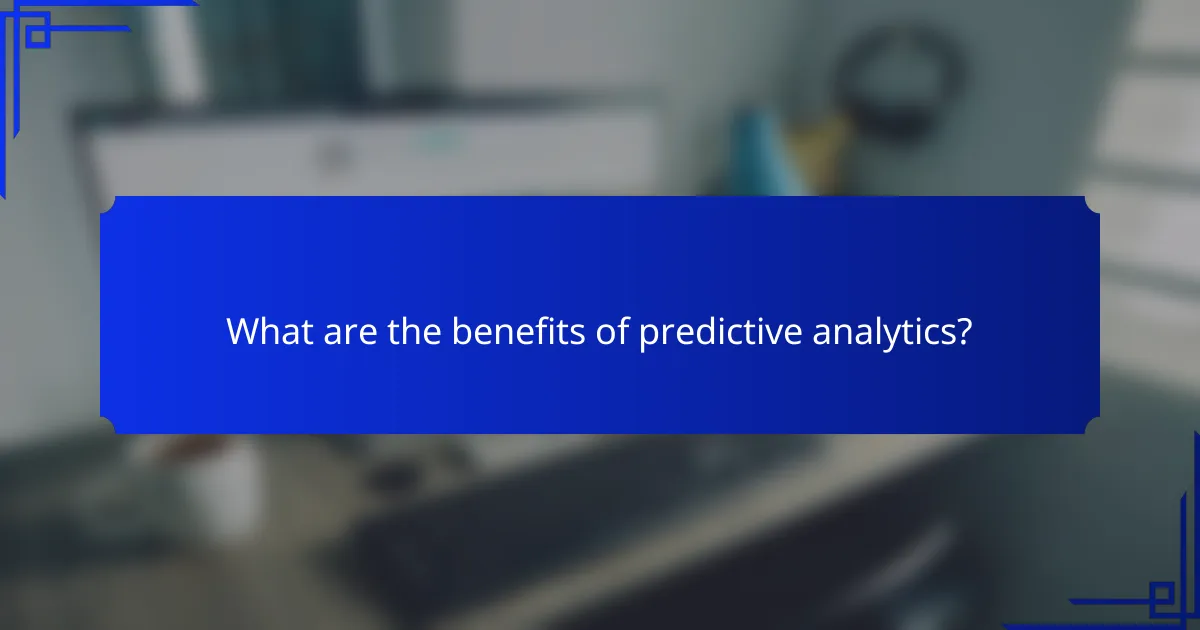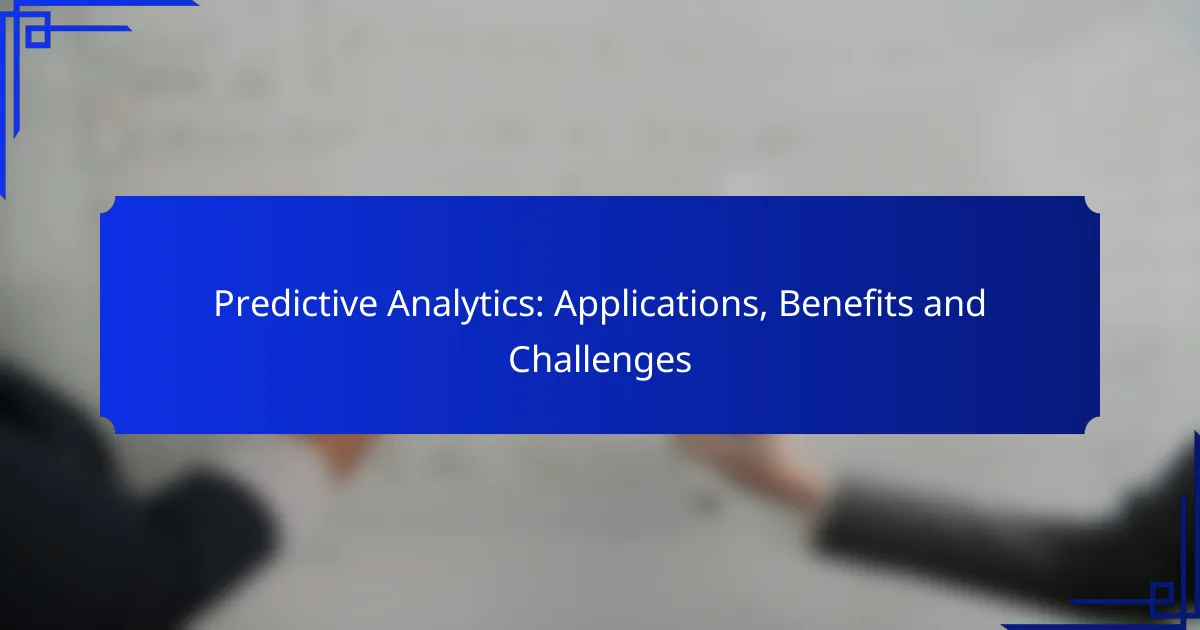Predictive analytics is a powerful tool that enables businesses to forecast future trends and behaviors by analyzing historical data. By leveraging this approach, organizations can enhance decision-making, improve efficiency, and create better customer experiences. However, challenges such as data quality, system integration, and privacy concerns must be addressed to fully harness the potential of predictive analytics.

What are the applications of predictive analytics in business?
Predictive analytics in business is used to forecast future trends and behaviors by analyzing historical data. This approach helps organizations make informed decisions across various domains, enhancing efficiency and profitability.
Customer behavior forecasting
Customer behavior forecasting involves analyzing past purchasing patterns to predict future buying habits. Businesses can use this information to tailor marketing strategies and improve customer satisfaction. For instance, retailers might identify seasonal trends, allowing them to stock popular items in advance.
To effectively forecast customer behavior, companies should segment their customer base and utilize data from multiple sources, such as social media and transaction histories. This multi-faceted approach can lead to more accurate predictions and targeted marketing efforts.
Supply chain optimization
Predictive analytics plays a crucial role in supply chain optimization by anticipating demand and managing inventory levels. By analyzing trends and external factors, businesses can streamline operations and reduce costs. For example, a manufacturer might predict a spike in demand for a product during a holiday season, enabling them to adjust production schedules accordingly.
To optimize the supply chain, companies should continuously monitor data and adjust their predictive models based on real-time information. This adaptability can help mitigate risks and improve overall efficiency.
Risk management
In risk management, predictive analytics helps organizations identify potential risks and assess their impact. By analyzing historical data, businesses can develop strategies to mitigate these risks before they escalate. For instance, financial institutions often use predictive models to assess credit risk and determine loan eligibility.
Effective risk management requires a robust data infrastructure and regular updates to predictive models. Companies should also consider external factors, such as economic conditions, to enhance their risk assessments.
Marketing campaign effectiveness
Predictive analytics can significantly improve the effectiveness of marketing campaigns by identifying the most promising channels and strategies. By analyzing past campaign data, businesses can determine which tactics yield the highest return on investment. For example, a company may find that email marketing generates more leads than social media ads.
To maximize campaign effectiveness, organizations should employ A/B testing and continuously refine their predictive models based on campaign performance. This iterative process allows for more precise targeting and better allocation of marketing resources.
Financial forecasting
Financial forecasting using predictive analytics enables businesses to project future revenues, expenses, and cash flows. By analyzing historical financial data, companies can make informed budgeting and investment decisions. For instance, a startup might use predictive models to estimate its funding needs for the next year.
To enhance financial forecasting accuracy, businesses should incorporate various data sources, including market trends and economic indicators. Regularly updating forecasts based on new data can help organizations stay agile and responsive to changing conditions.

What are the benefits of predictive analytics?
Predictive analytics offers numerous advantages, including enhanced decision-making, improved efficiency, and better customer experiences. By leveraging historical data and statistical algorithms, organizations can anticipate future trends and make informed choices that drive success.
Improved decision-making
Predictive analytics significantly enhances decision-making by providing data-driven insights. Organizations can analyze past behaviors and outcomes to forecast future scenarios, allowing leaders to make informed choices rather than relying on intuition alone.
For example, a retail company might use predictive models to determine which products are likely to sell well during a specific season, enabling them to optimize inventory levels and marketing strategies accordingly.
Increased operational efficiency
By identifying patterns and trends, predictive analytics helps organizations streamline operations. Businesses can optimize processes, reduce waste, and allocate resources more effectively, leading to smoother workflows.
For instance, a manufacturing firm can predict equipment failures before they occur, allowing for timely maintenance and minimizing downtime, which can save significant costs in the long run.
Enhanced customer satisfaction
Predictive analytics enables businesses to better understand customer preferences and behaviors, leading to improved satisfaction. By anticipating customer needs, companies can tailor their offerings and interactions to enhance the overall experience.
For example, an online retailer might analyze browsing patterns to recommend products that align with individual customer interests, resulting in a more personalized shopping experience.
Cost reduction
Implementing predictive analytics can lead to substantial cost reductions across various business functions. By optimizing inventory, improving resource allocation, and reducing operational inefficiencies, organizations can lower their overall expenses.
For instance, a logistics company could use predictive models to optimize delivery routes, reducing fuel costs and improving delivery times, which directly impacts the bottom line.
Competitive advantage
Organizations that effectively utilize predictive analytics gain a competitive edge in their respective markets. By leveraging insights to make proactive decisions, businesses can respond to market changes faster than their competitors.
For example, a financial institution might use predictive analytics to identify emerging market trends, allowing them to develop new products or services that meet evolving customer demands before others do.

What challenges do businesses face with predictive analytics?
Businesses encounter several challenges with predictive analytics, including data quality issues, integration with existing systems, skill gaps in analytics, privacy and security concerns, and high implementation costs. Addressing these obstacles is crucial for effectively leveraging predictive analytics to drive decision-making and improve outcomes.
Data quality issues
Data quality is a fundamental challenge in predictive analytics. Inaccurate, incomplete, or outdated data can lead to misleading predictions and poor business decisions. Businesses should implement robust data governance practices to ensure the integrity and reliability of their data sources.
Regular data cleaning and validation processes can help maintain high-quality datasets. Establishing clear standards for data entry and management can also reduce errors and enhance the overall effectiveness of predictive models.
Integration with existing systems
Integrating predictive analytics tools with existing systems can be complex and time-consuming. Businesses often face compatibility issues between new analytics platforms and legacy systems, which can hinder data flow and analysis. A well-planned integration strategy is essential for seamless operations.
To facilitate integration, organizations should assess their current technology stack and identify potential gaps. Investing in middleware solutions or APIs can help bridge these gaps and enable smoother data exchange between systems.
Skill gaps in analytics
Many organizations struggle with skill gaps in analytics, as the demand for data-savvy professionals often exceeds supply. This shortage can limit a company’s ability to effectively implement and utilize predictive analytics. Training existing staff and hiring skilled analysts are critical steps to overcoming this challenge.
Offering training programs and workshops can help upskill employees in data analysis and interpretation. Collaborating with educational institutions to create internship programs may also provide access to emerging talent in the analytics field.
Privacy and security concerns
Privacy and security concerns are significant challenges in predictive analytics, especially with the increasing scrutiny on data protection regulations such as GDPR. Companies must ensure that their data collection and analysis practices comply with legal standards to avoid penalties and maintain customer trust.
Implementing strong data encryption, access controls, and regular security audits can help safeguard sensitive information. Additionally, businesses should be transparent with customers about how their data is used and stored to build trust and mitigate privacy concerns.
High implementation costs
The costs associated with implementing predictive analytics can be a barrier for many businesses. Expenses may include software licensing, hardware upgrades, and personnel training. Organizations need to carefully evaluate their budget and prioritize investments that will yield the highest returns.
To manage costs, businesses can consider starting with pilot projects that require minimal investment. Demonstrating success on a smaller scale can help secure funding for broader implementation and justify the initial expenses involved in predictive analytics.

How to choose the right predictive analytics tools?
Choosing the right predictive analytics tools involves assessing their features, scalability, and vendor support. A well-selected tool can significantly enhance data-driven decision-making and improve business outcomes.
Evaluate features and capabilities
When evaluating predictive analytics tools, focus on their core features such as data visualization, machine learning algorithms, and reporting capabilities. Look for tools that offer user-friendly interfaces and customizable dashboards to facilitate easy analysis.
Consider whether the tool supports various data sources and formats, as well as its ability to handle large datasets efficiently. Tools that provide real-time analytics can offer a competitive edge by enabling timely decisions based on current data.
Consider scalability and integration
Scalability is crucial when selecting predictive analytics tools, especially for growing businesses. Ensure the tool can accommodate increasing data volumes and user numbers without compromising performance.
Integration capabilities with existing systems, such as CRM or ERP software, are also important. A tool that seamlessly connects with your current infrastructure will streamline workflows and enhance data accessibility.
Assess vendor support and training
Vendor support can greatly impact the successful implementation of predictive analytics tools. Look for vendors that offer comprehensive customer support, including troubleshooting and regular updates.
Training resources, such as tutorials, webinars, and documentation, are essential for maximizing the tool’s potential. A vendor that provides robust training options can help your team quickly become proficient in using the analytics tool effectively.
